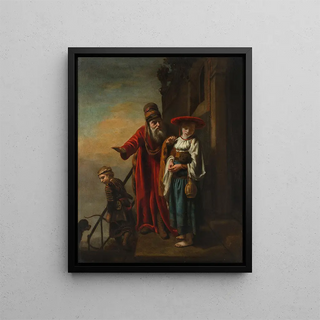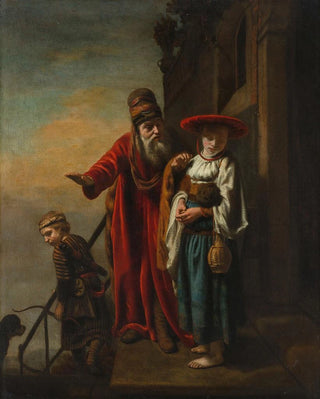Art print | Abraham sending Hagar and Ishmael - Nicolaes Maes


View from behind

Frame (optional)
Abraham renvoyant Agar et Ismaël - Nicolaes Maes – Engaging Introduction
The artwork "Abraham sending away Agar and Ishmael" by Nicolaes Maes presents itself as an emotionally charged and symbolic painting, evoking universal themes such as abandonment, faith, and destiny. This biblical scene, taken from the Old Testament, highlights the moment when Abraham, faced with a heartbreaking dilemma, is compelled to send away his concubine Agar and their son Ishmael, an act that resonates through the ages. The depiction of this pivotal moment, where tenderness and sorrow intertwine, invites us to reflect deeply on the difficult choices we sometimes must make in life. Maes's mastery in capturing human emotion makes this piece a must-see for anyone interested in art history and the complexity of human relationships.
Style and uniqueness of the work
Nicolaes Maes's style is distinguished by its ability to combine realism and spirituality. In "Abraham sending away Agar and Ishmael," every detail is carefully crafted, from the expressions of the characters to the nuances of light that envelop the scene. Influenced by his master Rembrandt, Maes uses light to emphasize emotions, creating a striking contrast between darkness and clarity. The faces of Abraham and Agar are imbued with an intensity that transcends the canvas, while Ishmael, innocent and vulnerable, embodies lost innocence. The composition, skillfully orchestrated, guides the viewer’s gaze across the scene, making palpable the dramatic tension it conveys. This painting is not only a visual representation but also an invitation to meditate on the ramifications of love and sacrifice.
The artist and his influence
Nicolaes Maes, active in the 17th century, is a Dutch artist whose work is rooted in the Baroque movement. A pupil of Rembrandt, he developed a distinctive style that combines his master’s influence with a unique sensitivity. Maes is renowned for his portraits and genre scenes, but it is in his biblical works that he reveals his full potential.

Matte finish

View from behind

Frame (optional)
Abraham renvoyant Agar et Ismaël - Nicolaes Maes – Engaging Introduction
The artwork "Abraham sending away Agar and Ishmael" by Nicolaes Maes presents itself as an emotionally charged and symbolic painting, evoking universal themes such as abandonment, faith, and destiny. This biblical scene, taken from the Old Testament, highlights the moment when Abraham, faced with a heartbreaking dilemma, is compelled to send away his concubine Agar and their son Ishmael, an act that resonates through the ages. The depiction of this pivotal moment, where tenderness and sorrow intertwine, invites us to reflect deeply on the difficult choices we sometimes must make in life. Maes's mastery in capturing human emotion makes this piece a must-see for anyone interested in art history and the complexity of human relationships.
Style and uniqueness of the work
Nicolaes Maes's style is distinguished by its ability to combine realism and spirituality. In "Abraham sending away Agar and Ishmael," every detail is carefully crafted, from the expressions of the characters to the nuances of light that envelop the scene. Influenced by his master Rembrandt, Maes uses light to emphasize emotions, creating a striking contrast between darkness and clarity. The faces of Abraham and Agar are imbued with an intensity that transcends the canvas, while Ishmael, innocent and vulnerable, embodies lost innocence. The composition, skillfully orchestrated, guides the viewer’s gaze across the scene, making palpable the dramatic tension it conveys. This painting is not only a visual representation but also an invitation to meditate on the ramifications of love and sacrifice.
The artist and his influence
Nicolaes Maes, active in the 17th century, is a Dutch artist whose work is rooted in the Baroque movement. A pupil of Rembrandt, he developed a distinctive style that combines his master’s influence with a unique sensitivity. Maes is renowned for his portraits and genre scenes, but it is in his biblical works that he reveals his full potential.






